Abstract
Water resources are increasingly under pressure because of human activities and economic development. Moreover, accelerated urbanization and the expansion of drinking water supply and sanitation systems contribute to this rising demand. The development of water reuse solutions is an urgent issue. This study presents a solution for the reuse of wastewaters generated from floor cleaning operations of industrial or public areas. A portable device containing a grid, for coarse filtration, and a 300-L reaction chamber to carry out the sequential processes of coagulation, flocculation and settling, was employed for a field test. In the field test the wastewater coming from the tank of a cleaning machine, used for floor cleaning in an industrial site, was treated and reused for the same purpose for a total of 110 times. The quality of the treated wastewater was monitored cycle after cycle and the results of the test demonstrated that the treated water was suitable to be reused for the same purpose, even after a large number of cycles, provided that a finishing treatment was eventually supplemented in order to reduce the residual concentration of organic substances. It was demonstrated that, under standard operating conditions, that is a wastewater with a total suspended solid (TSS) content of 800 mg/L, and on the grounds of the results found in the test, that is a TSS removal efficiency of 98% and a sludge total solid (TS) content of 6%, the whole volume of the cleaning machine tank was completely renewed with fresh water after 60 cycles. Eventually, the combination of treatment and reuse operations allowed to save approximately 18,000 L of fresh water over a series of 60 cleaning cycles. The proposed treatment allowed not only to save fresh water but even to reduce the cost of water usage by approximately 50%. In fact, thanks to this treatment, the cost of a single cubic meter of water decreased from approximately 6 €/m3, which included supply of fresh water and discharge to the public sewer, to approximately 3 €/m3.
1. Introduction
The survival and well-being of humans, as well as the development of most part of the economy sectors, rely on the availability of high-quality water [1]. However, every time humans access, develop, transport or utilize water resources, they leave an impact that may degrade the service provided by the surface or underground natural sources that supply water [2]. Even if the availability of high-quality water is decreasing all around the world, because of increased discharges of untreated sewage, agricultural runoff and inadequately treated wastewater from industry, the resort to water reuse solutions remains limited in comparison with their potential [3].
Floor cleaning processes carried out in industrial or public sites are a class of water-consuming daily operations. The cleanliness of surfaces in industrial places guarantees a more agreeable environment for workers and prevents the potential contamination of the processed goods. Meanwhile, maintaining a high level of cleanliness in public places, such as train stations and airports, is of capital importance to provide safe and dependable services to the passengers, and, above all, to help in contrasting the diffusion of health diseases [4,5]. These places experience huge volumes of passengers, especially during the high tourist season, and the consolidated passage of shoes and wheels brings soil, dust, garbage and the dirtiness of the town streets into the public place.
The preservation of natural fresh water can be obtained by minimizing the use of water of potable quality or by promoting the reuse of wastewater in cleaning operations of industrial or public areas. Most of the experiences that are focused on the sustainable utilization of water in cleaning operations, published in the last decade, are quite exclusively limited to the treatment and reuse of wastewater in the field of car washing. All those experiences had the common aim of coping with the problem of water scarcity in developing countries [6]. For example, Zaneti and coauthors [7] tested a flocculation-column flotation (FCF) unit, followed by sand filtration and final chlorination, in a full-scale car wash wastewater treatment and water recovery unit. Water usage and savings audits (20 weeks) showed that almost 70% reclamation was possible, and less than 40 L of fresh water per wash was attained [7,8]. Very recently, a laboratory-scale enhanced membrane bioreactor (eMBR) was proposed to treat car wash wastewater for recycling purpose. The eMBR consisted of an anaerobic tank, an anoxic tank, an aerobic membrane bioreactor and a UV disinfection unit. The treated wastewater produced by the eMBR met Class A recycling water quality standards [9]. For the treatment of a wastewater with the same origin, another author proposed a combination of settling, filtration, and membrane filtration processes [10]. Removal of total solids (TS) in the order of 50% was obtained through a raw settling. A final treatment on a nanofiltration (NF) membrane allowed chemical oxygen demand (COD) and conductivity to be reduced by 98% and 47%, respectively. Rodriguez Boluarte and coauthors [11] used a range of treatment processes, such as a membrane bioreactor (MBR), coagulation and ozonation, to treat car wash wastewater. They found that the ozonation was more effective in removing the chemicals and suspended solids than the coagulation process. The combination of the treatments, after the period of acclimatization of the MRB module, allowed the removal of 100% of suspended solids, 99.2% of COD, 97.3% of total organic carbon (TOC) and 41% of ammonia.
Strategies for fresh water saving were also employed to improve the environmental performances of bus-washing stations in Sao Paulo (Brazil). Almeida and coauthors demonstrated that the best environmental option was the installation of a wastewater treatment plant within the companies for internal water reuse [12]. However, in that work, the authors did not provide the details of the planned WWTP. All the studies mentioned above have demonstrated that there is a strong need for a water use policy that internalizes micro water recycling schemes in public water use as a mean of reducing water demand, harvesting and wastage through a number of irrational water uses [6]. Another recent study proposed an advanced treatment, through the combination of a sequential biological reactor (SBR) followed by an ultrafiltration, of grey water samples, for the possible reuse of the treated wastewaters in applications such as toilet flushing, laundering in first rinsing, floor cleaning, and irrigation [13]. They obtained values of the quality parameters (pH, EC, COD, BOD5, N-NH4+, N-NO3−, P-PO43−) that met permissible values for wastewater discharge to soil and water already after the SBR. The ultrafiltration improved the quality of the treated water and completely avoided the presence of microorganisms such as E. coli and enterococci. However, to the best of our knowledge, to date no case studies relating the treatment of wastewaters, coming from cleaning operations of floors of industrial or public places, to be reused for the same purpose, have been published.
This paper presents a case study in which the water, used for cleaning operations of industrial floors and collected by the cleaning machine, was repeatedly treated and reused for the same purpose. The treatment of the wastewater was carried out in an on-purpose made mobile equipment, that included a grid, for a preliminary coarse filtration, and a reaction chamber, for a physical—chemical treatment made of the phases of coagulation, flocculation and sedimentation. This easy, transportable device had the advantage to be placed and used for wastewater purification and reuse in places where cleaning operations of floors must be performed regularly. In this study, after a phase of optimization of the working conditions, the monitoring of the evolution of the characteristics of the water and sludge extracted from the portable device was carried out, at given intervals, from cycle 1 to cycle 110. The treatment apparatus and the pilot test presented in this paper have been conceived to make the wastewaters generated in cleaning operations of industrial/public areas suitable to be reused for the same purpose, thus saving fresh water.
2. Materials and Methods
2.1. Description of the Field Test
The field test was carried out with a cleaning machine with a reservoir of 265 L and a cleaning capacity of 6500 m2/h. For each working cycle, a floor area of 20,000 m2 in an industrial site was subjected to cleaning operations. The industrial site was located in the surroundings of Turin (NW Italy) and held several plants, most part of them were industries from the mechanical or logistic sectors. This choice was done in an effort of guaranteeing a high representativeness of the wastewater used in the pilot test, because the floor surface contamination may vary significantly depending on the type of industrial (or public) hall.
At the beginning of the test the reservoir of the cleaning machine was filled with a solution obtained by mixing a detergent with tap water, according to a dose of 20 g of detergent per liter of tap water. The detergent and the employed dose were recommended for cleaning operations of floors in public or industrial areas. According to the data reported on the label, the detergent contained 5% of non-ionic, completely biodegradable, surfactant compounds in the form of alkyl polyglucosides (APGs). The initial pH of the detergent was 7.5. The values of the main parameters of the tap water used for the field test are reported in Table 1.

Table 1.
Values of the main parameters of the tap water used for the tests.
The tap water had a slightly alkaline pH, equal to 8.16, an electrical conductivity (EC) of 217 uS/cm @ 25 °C and a TSS content under the detection limit. The concentrations of sodium, potassium, calcium and magnesium were 3.26, 0.90, 25.5 and 8.3 mg/L, respectively. The tap water EC value was in the low part of the range of the typical EC values of Italian mineral waters (100–700 uS/cm @ 25 °C). The concentrations of alkali and earth-alkali metals was in line with those of the most widespread mineral waters.
At the end of each working cycle, the machine reservoir was emptied and the wastewater was sent to a portable device where the treatment process was carried out. The portable device was made of a 4 mm grid, a reaction chamber, with a volume of 300 L, and a second reservoir with the same volume. The three pieces of equipment were used for the three stages in which the treatment process was articulated. The first stage was a coarse filtration on the 4 mm grid. The second stage was a coagulation—flocculation—sedimentation process carried out in the reaction chamber. A dose of 25 g of coagulant, in the form of poly-aluminum chloride (PAC, see Section 2.2.2), was added to 300 L of wastewater. That dose of coagulant was fixed after the phase of optimization, see Section 3.1. After the coagulant addition, the wastewater was vigorously stirred with a submerged mixer for 30 s and, finally, left to settle for at least 30 min, to allow the TSS to be separated from the water. The generated sludge was subsequently removed from the bottom of the reaction chamber. In the third stage, the clear water was moved to the second tank and there refilled with tap water, in order to compensate the water lost with sludge. Finally, a new dose of detergent and a dose of disinfectant (NaClO solution), to keep under control the presence of pathogens, were added.
The whole cycle of cleaning, wastewater treatment and reuse was repeated 110 times. The quality of the wastewater and sludge in the field test was analyzed after working cycles 1, 15, 30, 45, 60, 75, 90 and 110. The quality of the wastewater was analyzed after the coarse filtration stage and after the separation of the sludge (i.e., at the end of the treatment).
2.2. Optimization of the Treatment Conditions
2.2.1. Assessment of the Wastewater Composition
Preliminary tests were carried out to identify the average composition of the wastewater generated from floor cleaning operations, especially for what concerned the content of TSS. The assessment of the composition of the wastewater was necessary to fix the optimal conditions for the treatment of coagulation—flocculation and sedimentation. Samples of wastewater for the characterization phase were obtained from a set of cleaning operations carried out with the same cleaning machine and the same detergent solution employed in the field test. The cleaning operations of floors in the industrial site were repeated five times, each time on a dirty surface with an area of 20,000 m2. The wastewater samples were analyzed for what concerned pH, EC, TSS, alkalinity, chloride, alkali (Na, K), earth-alkali (Ca, Mg, Ba) and heavy (Al, Fe, Mn, Cd, Co, Cr, Cu, Ni, Pb, Zn) metals, COD. Finally, aliquots of the same volume (10 L) from the five wastewater samples were mixed together in order to obtain a representative sample on which the tests described in Section 2.2.2 and Section 2.2.3 have been carried out.
2.2.2. Coagulation Jar Tests
According to the current practice, in order to achieve the best results with coagulation, the process should be optimized for its main parameters, that is pH and concentration of coagulant [14,15]. In this study, aliquots of the wastewater obtained as in Section 2.2.1 were used for a sets of coagulation—flocculation—sedimentation tests aimed to find the most suitable coagulant dose. The coagulant used in these tests was provided by the company that owed the cleaning machine and was a solution of PAC. The solution had a strength of 17% (as Al2O3) and the pure substance had a basicity of 37%. Basicity gives a general idea of the amount of polynuclear material in the PAC. PAC is a highly efficient coagulant in a quite wide pH range (5–8), even at low temperatures, with a low generation of waste sludge, compared to other more conventional coagulants (i.e., alum). Because of the capacity of PAC to perform well also at slightly alkali pH values [16], tests were carried out at the natural pH value of the wastewater, thus meaning without pH correction. This choice was made in order to limit the amount of reactants to be added to the wastewater treatment system. No coagulant aids were used in this study.
The tests were carried out in a jar test apparatus, that consisted of six jars of 1000 mL each, on 600 mL of wastewater placed in each jar, to which different doses of the PAC solution were added. The range of PAC doses used for the test was fixed based on the results of previous studies [16,17]. Specifically, the dose of PAC solution was from 10 to 200 mg/L, to which corresponded a dose of pure substance from 1.7 to 34 mg/L.
2.2.3. Effect of the Biodegradation of Organic Substances from Surfactant Compounds on the Overall Performance of the Clarification Process
The wastewater to be treated for reuse contained organic substances in the form of non-ionic, completely biodegradable, surfactant compounds. Some tests were carried out to investigate the effect of the potential biodegradation of those organic substances, that occurred in the reaction chamber, on the removal efficiency of heavy metals in the coagulation—flocculation—sedimentation process. A set of treated wastewater samples obtained with the same apparatus already described in Section 2.2.2 were left in contact with its own bottom sludge for 3, 6, 24, 48 and 72 h. Containers were closed and kept in the dark in order to reproduce the conditions into the reaction chamber. This test wanted to simulate the effect of a prolonged contact, between the treated wastewater and the bottom sludge, on the quality of the clarified wastewater. A prolonged contact between clarified water and sludge can occur when, for several reasons, the immediate extraction of the settled sludge from the bottom of the reactor is not possible. The characteristics of the wastewater samples after contact of 3, 6, 24, 48 and 72 h with its own sludge were assessed for what concerned pH, EC, TSS, alkalinity, chloride, alkali (Na, K), earth-alkali (Ca, Mg, Ba) and heavy (Al, Fe, Mn, Cd, Co, Cr, Cu, Ni, Pb, Zn) metals.
2.3. Analytical Methods
Wastewater samples were analyzed for what concerned pH, EC, TS, alkalinity, chloride, COD, alkali (Na, K), earth-alkali (Ca, Mg, Ba) and heavy (Al, Fe, Mn, Cd, Co, Cr, Cu, Ni, Pb, Zn) metals according to Standards Methods [18]. Sludge samples were analyzed for their content in TS, volatile solids (VS), alkali (Na, K), earth-alkali (Ca, Mg, Ba) and heavy (Al, Fe, Mn, Cd, Co, Cr, Cu, Ni, Pb, Zn) metals. The metal content was obtained after sludge drying and microwave oven digestion of 250 mg of dried sample with a 4:1 (b.w.) mixture of nitric acid (65%) and hydrogen peroxide (30%). The solution resulting from the digestion process was filtered on a 542 Whatman filter and analyzed with an ICP-OES (Optima 2000, Perkin-Elmer, Waltham, MA, USA). Each wastewater and digestate sample was analyzed in triplicate. From each sludge sample three digestates were obtained.
3. Results and Discussion
3.1. Optimization of the Treatment Conditions
The preliminary cleaning tests were carried out with the aim of producing representative samples of wastewaters to be used in the phase of optimization of the treatment conditions. Those tests, carried out on a floor of an industrial site, revealed that the generated wastewater had a slightly alkali pH (8.0–8.5) and a TSS content that could range over one order of magnitude, approximately from 500 to 5000 mg/L. However, the most frequent TSS values were found at 500–800 mg/L. The concentration of organic substances expressed as COD was in the order of 1500–2000 mg/L. The COD content comes from both the organic substances collected from the floor and the residuals of detergent employed for cleaning. Metals in the wastewater were determined after filtration on a 0.45 μm filter. It was found that the ratio between Na:K and Ca:Mg was of 10:1, with an average of 400 mg/L of Na and 200 mg/L of Ca. Concentrations in the order of 0.5–1 mg/L were detected for iron, manganese and zinc. Finally, aluminum, copper and nickel had concentrations in the order of 100 μg/L and the concentrations of the other heavy metals were of less than 10 μg/L. The detailed results concerning the characterization of the generated wastewater are reported in Table 2.

Table 2.
Quality of the wastewater obtained from the preliminary cleaning tests (mean value ± standard deviation).
The results of the coagulation—flocculation—sedimentation tests, carried out on the generated wastewater with the aim of finding the optimal coagulant dose, are shown in Figure 1. In this phase the focus of the tests was primarily on the removal of TSS.
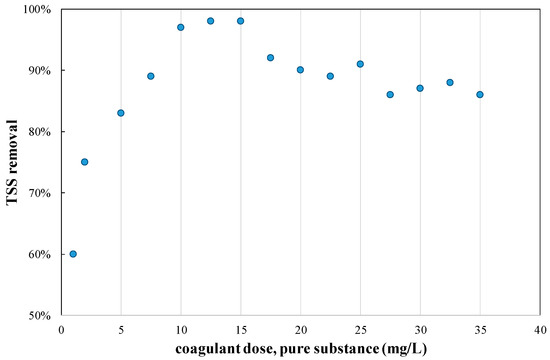
Figure 1.
Removal of TSS in the coagulation—flocculation—sedimentation tests carried out with different doses of the PAC solution.
The results of Figure 1 show that, in the presence of the natural pH value and of the peculiar characteristics of the wastewater generated from the cleaning operations in the industrial site, doses of PAC from 1.7 to approximately 10 mg/L determined an increase in the TSS removal. Conversely, doses of more than 10 mg/L (up to 15–16 mg/L) did not affect the TSS removal performance, that reached a plateau (98–99% removal), whereas higher doses (up to 30–34 mg/L) determined a deterioration in the TSS removal efficiency. The results of Figure 1 demonstrated that doses of PAC in the order of 10–15 mg/L of pure substance were able to obtain residual concentrations of TSS of 1–2% of the initial value, irrespective of the initial TSS concentration. The optimum dose found in these tests was in line with the dose reported by Gebbie [19] for the treatment of a colored, low turbidity water (Otway region, Victoria, Australia) compared to similar performance observed when using an alum dose of 55 mg/L.
After having found the optimal coagulant dose range for TSS removal, that is 10–15 mg/L of pure coagulant, a control was made on the residual concentrations of metals in the treated wastewater. Special attention was devoted to the heavy metals that were present at the highest concentration values in the wastewater, that is Fe, Mn, Cu, Ni and Zn; because of the nature of the coagulant, a control was also made on aluminum. As it can be seen from Figure 2, the highest dose in the optimal working range was preferred because it proved to be efficient not only in the TSS removal but also in the reduction of the concentration of dissolved metals.
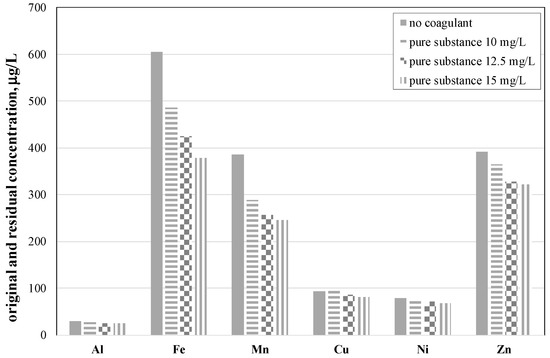
Figure 2.
Removal of metals in the coagulation—flocculation—sedimentation tests carried out with the optimized dose range (10–15 mg/L) of the PAC solution.
However, Figure 2 shows that the physical—chemical process had only a limited effect in the removal of heavy metals. Efficiencies ranging from 15% to 40%, depending on the metal, were observed at the best coagulant dose. Consequently, on the basis of the results of the tests presented in this Section, a dose of 25 g of coagulant solution in 300 L of wastewater (that is 4.5 g of pure substance) was selected for the field test.
3.2. Effect of the Biodegradation of Organic Substances from Surfactant Compounds on the Overall Performance of the Clarification Process
The second step of the study was aimed at investigating the effect of a possible biodegradation of the surfactant compounds on the overall performance of the clarification process, specifically on the removal of heavy metals. This step was necessary because the detergent solution planned to be used in the field test was made of organic substances that could be rapidly degraded. The occurrence of a biological process can change the characteristics of the environment and thus affects the overall performance of the clarification process. The surfactant compounds in the detergent solution were in the form of APGs. APGs are the ingredients of most of the biodegradable, non-ionic surfactant compounds found in dishwashing detergents, liquid detergents and special detergents for industrial cleaning operations. The use of such substances is ever more widespread due to their good foaming properties [20,21]. APGs consist on a hydrophobic alkyl chain and sugar hydrophilic derivatives. The basis for APG production is a reaction between fatty alcohols and glucose. Fatty alcohols can be obtained from either petrochemical sources (synthetic fatty alcohols) or natural, renewable resources, such as fats and oils [22]. Since this new generation of surfactants molecules contain biocompatible functional groups, they are capable of being subjected to biological reactions [23].
The monitoring of the quality of the clarified wastewater in contact with its own sludge for 3, 6, 24, 48 and 72 h revealed that the pH value decreased over time, passing from a neutral value to acidic values (see Figure 3). The observed decrease in the pH value was a signal of an incipient biological activity into the clarification reactor. In fact, in the absence of free oxygen, the reactions of hydrolysis and acidification transform the rapidly biodegradable organic substances into metabolites of low molecular weight such as alcohols and short-chain volatile fatty acids (C2–C4 organic acids) [24]. The accumulation of these acids led to an acidic pH into the clarified water. It can be seen from Figure 3 that the concentration of some heavy metals into the clarified water increased from the first to the last hours of contact.
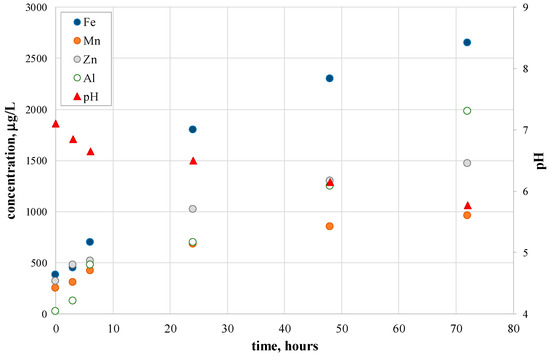
Figure 3.
Quality of the wastewater (pH, concentration of heavy metals) after a prolonged contact (3–72 h) with the separated sludge.
Because the removal of metals from the wastewater was achieved thanks to the precipitation reactions of salts, mainly in the form of carbonates, and hydroxides, if the pH decreased, the chemical equilibrium shifted towards the undissociated species and determined a new dissolution of the heavy metals. The results of this test demonstrated that, firstly, the sludge generated from TSS and metal precipitate settling must be removed from the tank shortly after the clarification process, thus avoiding metal re-dissolution. Secondly, a supplementary treatment should be planned to remove the organic compounds coming from the addition of the detergent. In fact, because of their high biodegradability, it is highly recommended to treat these compounds with a dedicated biological treatment in order to avoid pH alteration and consequent metal re-dissolution into the treated wastewater.
3.3. Results of the Field Test
The quality of the wastewater was analyzed before and after the treatment after a fixed number of working cycles. Some of the main results of the monitoring activity carried out during the field test are shown in Figure 4, Figure 5 and Figure 6.
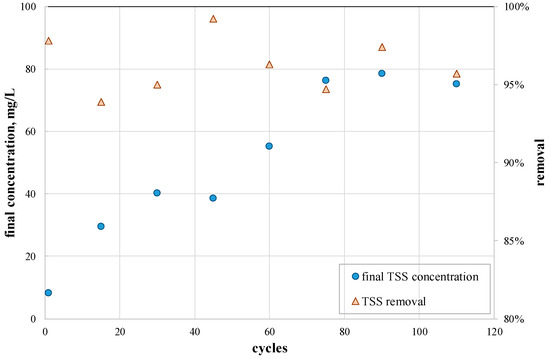
Figure 4.
Trend of the TSS concentration after the treatment and TSS efficiency removal.
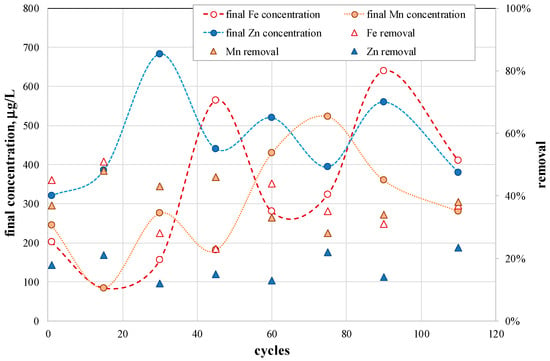
Figure 5.
Trend of iron, manganese and zinc concentration after the treatment and efficiency removal.
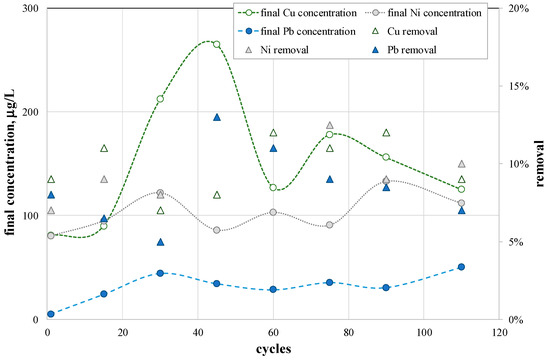
Figure 6.
Trend of copper, nickel and lead concentration after the treatment and efficiency removal.
Figure 4 shows that the residual amount of TSS increased from a few mg/L, after the first treatment cycle, to the nearly constant value of approximately 80 mg/L in the last part of the test. It can be seen that, even if the residual TSS content after the clarification process increased from cycle to cycle, the TSS removal efficiency was always very high, in the order of 95%. As expected, this figure was very close to 100% when the starting TSS value was in the order of a few thousands of mg/L. For what concerns the TSS removal, the treatment proved to work efficiently from the beginning to the end of the test.
As it can be seen from Figure 5 and Figure 6, the final concentrations of the heavy metals found at the highest levels (i.e., Fe, Mn, Zn, Cu, Ni) in the wastewater showed fluctuations and a no definite trend could be identified from the beginning to the end of the test. The wastewater showed an enrichment of the lead content, which passed from a concentration of a few μg/L, in the very first part of the test, to a nearly constant concentration values in the order of 50 μg/L. As expected, the treatment of clarification proved to have a limited removal capacity towards all the afore-mentioned heavy metals. For example, from Figure 5 it can be seen that the removal efficiency was in the order of 17% for zinc and of approximately 36–37% for iron and manganese. Figure 6 shows that the removal efficiency of copper, nickel and lead was only in the order of 10%.
The concentration of most part of the heavy metals in the wastewater was of a few hundreds of ug/L or less. Processes such as coagulation and flocculation have generally a very a limited efficacy in heavy metal removal, when concentration values are of limited extent (1 mg/L or less). In fact, the main targets of the processes of coagulation and flocculation are only the hydrophobic colloids and suspended particles [25]. As it can be seen from Figure 5 and Figure 6, the treatment presented in this study shows a scarce and non- reproducible efficacy in heavy metal removal. Recent studies have demonstrated that the removal of heavy metals from wastewaters could be obtained at quite high levels when appropriate reactants, such as chitosan, are employed in the processes of coagulation and flocculation. A comprehensive review paper [26] showed that chitosan exhibited a high capacity of heavy metal removal through processes of flocculation and adsorption. Chitosan has a macromolecular structure that could be easily modified with the addition of specific surface groups. Some studies demonstrated that the capacity of high-molecular substances to remove heavy metal through chelation and capture processes drastically improved because of the enhanced hydrophilic properties obtained via hydroxylation, acylation, carboxylation, and other derivatization reactions of the molecular terminal groups [27,28].
With reference to the other monitored parameters, it can be seen from Figure 7 that the pH value of the clarified water increased from neutral values to slightly alkaline values, to reach a constant value of approximately 9.0 in the last cycles of the tests. This observation was in agreement with the trend of the alkalinity that increased by approximately ten times, from 53.6 mg CaCO3eq/L in the tap water to approximately 500 mg CaCO3eq/L in the treated wastewater at the very last cycles. The increase in the availability of bicarbonate and carbonate species in the water used for the cleaning operations determined a better precipitation of earth-alkali metals, that corresponded to a general decreasing trend of the concentrations of calcium, magnesium and barium (data not shown).
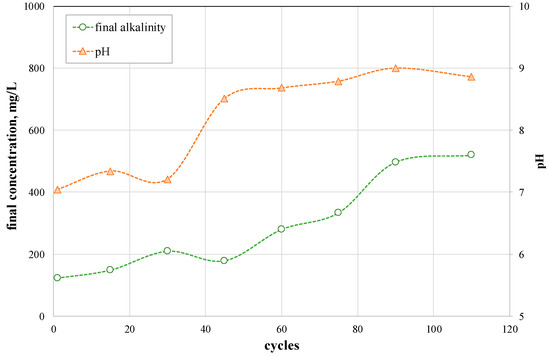
Figure 7.
Trend of pH and alkalinity after the treatment.
The concentration of chloride and aluminum did not show evident changes before and after the treatment with PAC (Figure 8). This evidence was an indication that the immediate removal of the sludge after the settling phase was able to keep the possible re-dissolution of the precipitated species and the stability of the coagulant matrix under control. Dissolution of chloride, aluminum and other heavy metals could occur in the case of a deviation of the clarified wastewater towards an acidic environment. It can be concluded that the treatment presented in this study had, in the overall, from the first to the last working cycles, a positive effect on the decrease of the values of most part of the analyzed parameters. It must be underlined that the process was chiefly designed to abate the TSS from the wastewater and make the treated water suitable for new cycles of cleaning operations.
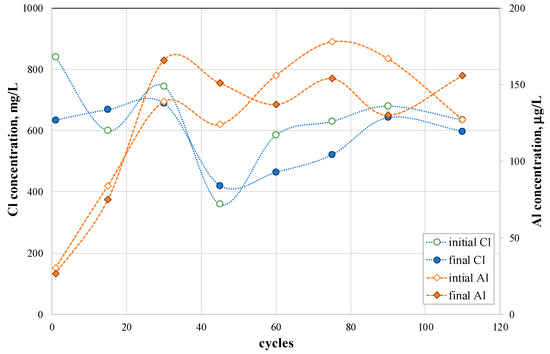
Figure 8.
Trend of aluminum and chloride before and after the treatment.
After the sedimentation in the reaction chamber, the sludge was transferred in a dedicated tank and the quality of the stored sludge was analyzed after the fixed number of working cycles. It can be seen from Table 3 that the average TS content of the sludge after the first working cycle was in the order of 6.5% and it increased to values in the order of 9% at the end of the field test, with a progressive accumulation of sludge in the tank. The ratio between VS and TS remained at the approximate constant value of 30%. The content of alkaline metals (Na and K) and most part of the heavy metals, with the exception of aluminum, iron and copper, remained practically constant in the sludge with increasing work cycles.

Table 3.
Results of the sludge characterization.
Conversely, the content of calcium and magnesium increased from cycle to cycle. This observation was in agreement with the progressive increase in the alkalinity observed in the clarified wastewater. Salts of calcium and magnesium, mainly in form of bicarbonate, carbonate and sulfate, are widespread almost everywhere, in urban and industrial environments, and are captured from the surfaces thanks to cleaning operations. Part of those salts remains into the clarified wastewater but the part that exceeds the saturation concentration is removed through precipitation and settling. In the case of the presented treatment, the process of precipitation is aided by the addition of the coagulant, that is able to capture the smallest and lightest particles, dragging them downwards.
The content of aluminum in the sludge showed a progressive decrease from values in the order of 3.5% to almost constant values in the order of 2.5%. This value was very close to the concentration that could be found in the sludge if all the aluminum was brought by the coagulant. In fact, the dose of aluminum added to one liter of water was of 15 mg (4.5 g for each batch) and the average TS content of the wastewater was of 500–800 mg/L at every cycle. This determined an aluminum content in the sludge in the range 2–3%, in line with that found from the sludge analysis. From the characterization of the sludge, it could be concluded that its quality did not show an evident deterioration cycle after cycle.
3.4. Comparison of the Obtained Results with the Current Italian Legislation on Water Reuse
In Italy, Ministerial Decree (DM) 12 June 2003 n. 85 governs the reuse of treated wastewater. According to the Decree, there are three intended uses of the treated wastewaters, that is for irrigation, civil activities and industrial processes. The Decree fixes threshold values for irrigation and civil activities; conversely, a reclaimed wastewater is considered to be suitable for industrial uses if the values of the parameters are below the thresholds fixed for the discharge in superficial water bodies (DM 152/06, Annex V, Table 3). The comparison between the residual concentration values found at the end of the test (cycle 110) and the threshold values fixed by the Italian law is reported in Table 4.

Table 4.
Comparison between the residual concentration values found at the end of the test (cycle 110) and the threshold values fixed by the Italian law (DM 12 June 2003, n. 85).
From the values of Table 4 it can be seen that the characteristics of the wastewater achieved thanks to the treatment made it suitable to be reused for cleaning operations in industrial sites. In this case a special attention must be devoted to the residual concentration of copper, because at some times of the test it exceeded the value fixed by the law. Decree n. 85/2003 imposes a very severe limit for what concerns the residual presence of TSS in a water to be reused for cleaning operations of public places (the Decree mentions the cleaning of urban streets as a possible civil reuse). That value can be achieved with great difficulty with the sole process of clarification, especially if the treated wastewater is subjected to repeated cycles of treatment and reuse.
Furthermore, finishing treatments such as enhanced biological processes, chemical oxidation treatments (i.e., ozonation) or enhanced filtration systems (nanofiltration or reverse osmosis) are deemed to be necessary to reduce the concentration of COD below the threshold value (160 mg/L) set for the reuse in cleaning operations in industrial sites. In fact, the sole treatment of coagulation, flocculation and sedimentation is not sufficient to reduce COD to such a low value. According to the information reported in the Reference Document concerning the “Common Wastewater and Waste Gas Treatment/Management Systems in the Chemical Sector” [29], the combination of the processes of coagulation, flocculation and sedimentation has an efficiency in the removal of COD/TOC in the order of 20–60%. The average amount of soluble COD introduced with the surfactant at every cycle of cleaning was in the order of 1400 mg/L, that means that the sole physical—chemical process was able to reduce that concentration to values in the order of 700 mg/L or more, at least seven times the threshold value required by the Italian law. However, it must be taken into account that the benefit of the proposed solution was the possibility of using a simple, low-cost, low-energy, portable system to treat wastewater in the same place where it was generated. The treated wastewater was safe for what concerned the residual presence of pathogens because sodium hypochlorite (NaClO) was added after every treatment cycle.
3.5. Cost Assessment to Produce Water for Reuse
The amount of water that could be saved after every treatment cycle depended on three main factors, that is the concentration of TSS in the wastewater, the efficiency of the process in TSS removal and the TS concentration that could be reached in the sludge. A calculation of the water saving capacity of this treatment system can be carried out under the following hypotheses: a wastewater with an average quality is considered, that is with a TSS content of 800 mg/L; a TSS removal efficiency of 98%; a sludge TS content of 6%. In this case, an amount of TSS in the order of 235 g would be removed from the wastewater in the form of sludge at every treatment cycle. The volume of produced sludge would be in the order of 4 L. That means that at maximum 5 L of fresh water must be added to refill the tank of the cleaning machine to compensate the water lost with the sludge and because of evaporative processes; consequently, the whole volume of the tank would be renewed after 60 cycles. In the very end, this operation would allow to save approximately 18,000 L of fresh water over a series of 60 cleaning cycles. On the grounds of the aforementioned calculations, Figure 9 and Figure 10 show the number of treatment cycles after which the volume of water into the tank of the cleaning machine (300 L) is completely renewed.
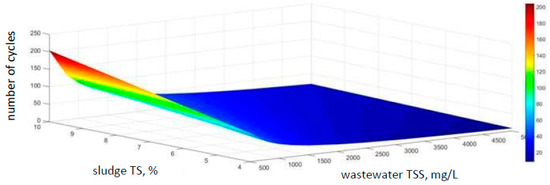
Figure 9.
Number of cycles after which the volume of water into the cleaning machine tank is completely renewed.
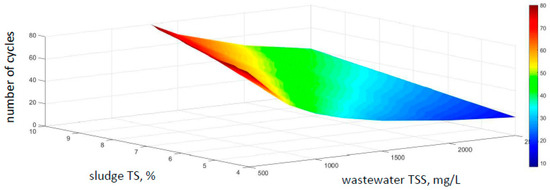
Figure 10.
Number of cycles after which the volume of water into the cleaning machine tank is completely renewed (detail for a TSS wastewater content in the range 0–2500 mg/L).
An assessment of the costs required to produce water for reuse using the portable device described in Section 2.1 is reported here. As in previous works, the main cost items considered for the economic assessment were: depreciation, maintenance, utilities and raw materials, waste disposal and labor [30,31]. The treatment device was used for 8 h every day, 220 days per year.
The depreciation was calculated by making reference to the total fixed costs (TFCs) of the portable device. The TFCs are paid in a number of years through a constant annual installment which was calculated by multiplying the TFCs by the capital charge rate (CCR) [32]. The CCR is a function of the annual interest rate (i) and the operating lifetime (n), as in Equation (1), which were fixed to 6% and 5 years, respectively
The TFC of the portable device was calculated as the sum of the TFCs of each of the parts which constitute the treatment system, that is: the grid for coarse filtration, the reaction chamber and a stirrer. The cost of each piece of equipment was obtained from a dedicated website [33]. Table 5 shows the main characteristics and the costs of each piece of equipment.

Table 5.
Main characteristics and costs of each piece of equipment used for the portable treatment device.
It can be seen from Table 5 that the TFC was of 4760 €; this amount was increased by 20% (approximately 950 €) to cover the expenses for the device assembly [34]. From Equation (1) a CCR of 0.237 was calculated and, consequently, an annual installment of 1130 €.
As it can be seen from Table 6, the cost for the maintenance of the device was estimated equal to 10% of the cost of the device, which includes TFC and cost for the assembly/installation [34]. The treatment device can carry out up to 10 working cycle every day, thus considering that each treatment cycle lasts approximately 45 min. That means that every day a volume of 3 m3 of water could be treated and reused. Conversely, a volume of 50 L of water (approximately 5 L for each batch, as mentioned at the beginning of this Section) must be restored every day in order to compensate the amount of water lost with the sludge.

Table 6.
List of the cost items for the treatment to produce water for reuse.
Utilities include electric energy and water. The Italian unit cost of electrical energy is on the order of 0.25 €/kWh [35] and the treatment device consumes approximately 130 kWh/year. This resulted in an electricity cost of 50 €/year. The unit cost of water for industrial activities is in the order of 4 €/m3. Consequently, the treatment device needs 11 m3 of clean water every year, with a cost of 44 €. Furthermore, the treatment need PAC, in the measure of 15 g of pure substance per cubic meter of treated water. The cost of a standard tank (25 L) of a 17% PAC solution is in the order of 35–40 €. The treatment device can treat approximately 660 m3 of water per year, with a requirement of 9.9 kg of pure PAC, that corresponds to approximately 2.3 tanks, at a total cost of 90 €. Finally, the sludge produced from the treatment operation must be properly disposed. The unit cost for sludge transport and disposal is in the order of 20 €/m3 [36]. One treatment batch generated approximately 4 L of sludge with 6% TS content; in one year, 2200 batches generate 8.8 m3 of sludge, with an involved disposal cost of approximately 180 €. The labor cost was fixed equal to zero, because the easy operations necessary for water purification can be carried out by the cleaning machine driver.
Based on the previous calculation, the unit cost for water treatment for reuse was in the order of 3.1 €/m3. This cost must be compared with a cost of approximately 6 €/m3, which includes the cost for the supply of raw water to be used for industrial purposes (4 €/m3) and an average cost for the discharge of the wastewater in the public sewer, quite variable from area to area but in the order of 2 €/m3.
4. Conclusions and Final Recommendations
The treatment carried out in this field study, made of the phases of coarse filtration followed by coagulation, flocculation and sedimentation, proved to be efficient to make the treated wastewater suitable for an industrial reuse. In fact, the residual concentrations of TSS, heavy metals and chloride were below the threshold values fixed by the Italian law. However, these values could be obtained only with a careful control of the working conditions. In fact, it was demonstrated that a prolonged contact between sludge and water deteriorated the characteristics of the water. Finishing treatments, such as enhanced biological processes, chemical oxidation treatments (i.e., ozonation) or enhanced filtration systems (nanofiltration or reverse osmosis), were deemed to be necessary to reduce the concentration of COD that was found to be the most critical parameter for the reuse.
The proposed solution for wastewater reuse offered the advantage of using a simple, low-cost, low-energy, portable system to treat wastewater in the same place where it was generated. This operation would allow to save approximately 18,000 L of fresh water over a series of 60 cleaning cycles. In terms of money saving, the cost of a single cubic meter of water decreased from approximately 6 €/m3, which included supply and discharge to the public sewer, to approximately 3 €/m3.
Funding
This research was partially funded by Perpulire s.r.l., through research contract 125/2017.
Acknowledgments
The author wishes to thank Giuseppe Campo and Alberto Cerutti for fruitful discussions. The Environmental Chemistry Lab from DIATI is acknowledged for providing the instrumental resources for the study. Finally, three anonymous reviewers are thanked for their helpful comments.
Conflicts of Interest
The author declares no conflict of interest.
References
- Voulvoulis, N. Water reuse from a circular economy perspective and potential risks from an unregulated approach. Curr. Opin. Environ. Sci. Health 2018, 2, 32–45. [Google Scholar] [CrossRef]
- Kaaya, L.T.; Lugomela, G.V. Local Pressures and Drivers of Aquatic Ecosystem Change. In Ecosystem Services and River Basin Ecohydrology; Chicharo, L., Müller, F., Eds.; Springer: Berlin, Germany, 2015. [Google Scholar]
- Alcalde-Sanz, L.; Gawlik, B.M. Minim. quality requirements for water reuse in agricultural irrigation and aquifer recharge. EUR 28962 EN. JRC Tech. Rep. 2017. [Google Scholar] [CrossRef]
- Baxter, G.; Srisaeng, P.; Wild, G. An Assessment of Airport Sustainability: Part 3—Water Management at Copenhagen Airport. Resources 2019, 8, 135. [Google Scholar] [CrossRef]
- El-Nwsany, R.I.; Maarouf, I.; Abd el-Aal, W. Water management as a vital factor for a sustainable school. Alex. Eng. J. 2019, 58, 303–313. [Google Scholar] [CrossRef]
- Ndi, H.N. Estimating wasteful water use from car washing points on the water supply system of Yaounde, Cameroon. GeoJournal 2018, 83, 1–12. [Google Scholar] [CrossRef]
- Zaneti, R.; Etchepare, R.; Rubio, J. Car wash wastewater reclamation. Full-scale application and upcoming features. Resour. Conserv. Recycl. 2011, 55, 953–959. [Google Scholar] [CrossRef]
- Zaneti, R.N.; Etchepare, R.; Rubio, J. Car wash wastewater treatment and water reuse—A case study. Water Sci. Technol. 2013, 67, 82–88. [Google Scholar] [CrossRef]
- Moazzem, S.; Ravishankar, H.; Fan, L.; Roddick, F.; Jegatheesan, V. Application of enhanced membrane bioreactor (eMBR) for the reuse of carwash wastewater. J. Environ. Manag. 2020, 254, 109780. [Google Scholar] [CrossRef]
- Uçar, D. Membrane processes for the reuse of car washing wastewater. J. Water Reuse Desalin. 2018, 8, 169–175. [Google Scholar] [CrossRef]
- Boluarte, I.A.R.; Andersen, M.; Pramanik, B.K.; Chang, C.Y.; Bagshaw, S.; Farago, L.; Jegatheesan, V.; Shu, L. Reuse of car wash wastewater by chemical coagulation and membrane bioreactor treatment processes. Int. Biodeterior. Biodegr. 2016, 113, 44–48. [Google Scholar] [CrossRef]
- Almeida, C.M.V.B.; Borges, D., Jr.; Bonilla, S.H.; Giannetti, B.F. Identifying improvements in water management of bus-washing stations in Brazil. Resour. Conserv. Recycl. 2010, 54, 821–831. [Google Scholar] [CrossRef]
- Kamińska, G.; Marszałek, A. Advanced Treatment of Real Grey Water by SBR Followed by Ultrafiltration—Performance and Fouling Behavior. Water 2020, 12, 154. [Google Scholar] [CrossRef]
- Domopoulou, A.; Moustakas, K.; Baklavaridis, A.; Koukouzas, N.; Karayannis, V. Wastewater treatment for reuse employing industrial by-products as alternative coagulants. Desalin. Water Treat. 2017, 91, 55–63. [Google Scholar] [CrossRef]
- Racar, M.; Dolar, D.; Farkaš, M.; Milčić, N.; Špehar, A.; Košutić, K. Rendering plant wastewater reclamation by coagulation, sand filtration, and ultrafiltration. Chemosphere 2019, 227, 207–215. [Google Scholar] [CrossRef]
- Wei, N.; Zhang, Z.; Liu, D.; Wu, Y.; Wang, J.; Wang, Q. Coagulation behavior of polyaluminum chloride: Effects of pH and coagulant dosage. Chin. J. Chem. Eng. 2015, 23, 1041–1046. [Google Scholar] [CrossRef]
- Kumar, N.; Balasundaram, N. Efficiency of PAC in Water Treatment Plant & Disposal of Its Sludge. Int. J. Appl. Eng. Res. 2017, 12, 3253–3262. [Google Scholar]
- APHA, AWWA, WEF. Standard Methods for the Examination of Water and Wastewater, 22nd ed.; American Public Health Association: Washington, DC, USA, 2012; ISBN 978-087553-013-0. [Google Scholar]
- Gebbie, P. Using polyaluminum coagulants in water treatment. In Proceedings of the 64th Annual Water Industry Engineers and Operators Conference, Bendigo, Victoria, Australia, 5–6 September 2001; Available online: http://wioa.org.au/conference_papers/2001/pdf/paper6.pdf (accessed on 21 January 2020).
- Geetha, D.; Tyagi, R. Alkyl Poly Glucosides (APGs) Surfactants and Their Properties: A Review. Tenside Surfactants Deterg. 2012, 49, 417–427. [Google Scholar] [CrossRef]
- Li, G.; Chen, L.; Ruan, Y.; Guo, Q.; Liao, X.; Zhang, B. Alkyl polyglycoside: A green and efficient surfactant for enhancing heavy oil recovery at high-temperature and high-salinity condition. J. Pet. Explor. Prod. Technol. 2019, 9, 2671–2680. [Google Scholar] [CrossRef]
- Bhadani, A.; Iwabata, K.; Sakai, K.; Koura, S.; Sakai, H.; Abe, M. Sustainable oleic and stearic acid based biodegradable surfactants. RSC Adv. 2017, 7, 10433. [Google Scholar] [CrossRef]
- Merrettig-Bruns, U.; Jelen, E. Anaerobic Biodegradation of Detergent Surfactants. Materials 2009, 2, 181–206. [Google Scholar] [CrossRef]
- Li, G.; Lan, G.; Liu, Y.; Chen, C.; Lei, L.; Du, J.; Lu, Y.; Li, Q.; Du, G.; Zhang, J. Evaluation of biodegradability and biotoxicity of surfactants in soil. RSC Adv. 2017, 7, 31018. [Google Scholar] [CrossRef]
- Fu, F.; Wang, Q. Removal of heavy metal ions from wastewaters: A review. J. Env. Manag. 2011, 92, 407–418. [Google Scholar] [CrossRef]
- Yang, R.; Li, H.J.; Huang, M.; Yang, H.; Li, A.M. A review on chitosan-based flocculants and their applications in water treatment. Water Res. 2016, 95, 59–89. [Google Scholar] [CrossRef]
- Teh, C.Y.; Budiman, P.M.; Budiman, K.; Shak, Wu, T.Y. Recent advancement of coagulation-flocculation and its application in wastewater treatment. Ind. Eng. Chem. Res. 2010, 55, 4363–4389. [Google Scholar] [CrossRef]
- Sun, Y.; Zhou, S.; Pan, S.Y.; Zhu, S.; Yu, Y.; Zheng, H. Performance evaluation and optimization of flocculation process for removing heavy metal. Chem. Eng. J. 2020, 385, 123911. [Google Scholar] [CrossRef]
- Brinkmann, T.; Santonja, G.G.; Yükseler, H.; Roudier, S.; Sancho, L.D. Best Available Techniques (BAT) Reference Document for Common Wastewater and Waste Gas Treatment/Management Systems in the Chemical Sector. In JRC Science for Policy Report; European IPPC Bureau: Roma, Italy, 2016. [Google Scholar]
- Ruffino, B.; Zanetti, M.C. Recycling of steel from grinding scraps: Reclamation plant design and cost analysis. Resour. Conserv. Recycl. 2008, 52, 1315–1321. [Google Scholar] [CrossRef]
- Ruffino, B.; Zanetti, M.C.; Marini, P. A mechanical pre-treatment process for the valorization of useful fractions from spent batteries. Resour. Conserv. Recycl. 2011, 55, 309–315. [Google Scholar] [CrossRef]
- Ruffino, B.; Zanetti, M.C. Present and future solutions of waste management in a candied fruit-jam factory: Optimized anaerobic digestion for on site energy production. J. Clean. Prod. 2017, 159, 26–37. [Google Scholar] [CrossRef]
- Matches. Available online: https://www.matche.com/equipcost/Default.html (accessed on 27 February 2020).
- Turton, R.; Bailie, R.C.; Whiting, W.B.; Shaeiwitz, J.A.; Bhattacharyya, D. Analysis, Synthesis, and Design of Chemical Processes, 4th ed.; Pearson College Div: Ann Arbor, MI, USA, 2012; p. 1007. ISBN 978-0132618120. [Google Scholar]
- Luce-gas. Available online: https://luce-gas.it/business/offerte/costo-kwh-aziende (accessed on 27 February 2020). (In Italian).
- Kalderis, D.; Aivalioti, M.; Gidarakos, E. Options for sustainable sewage sludge management in small wastewater treatment plants on islands: The case of Crete. Desalination 2010, 260, 211–217. [Google Scholar] [CrossRef]
© 2020 by the author. Licensee MDPI, Basel, Switzerland. This article is an open access article distributed under the terms and conditions of the Creative Commons Attribution (CC BY) license (http://creativecommons.org/licenses/by/4.0/).